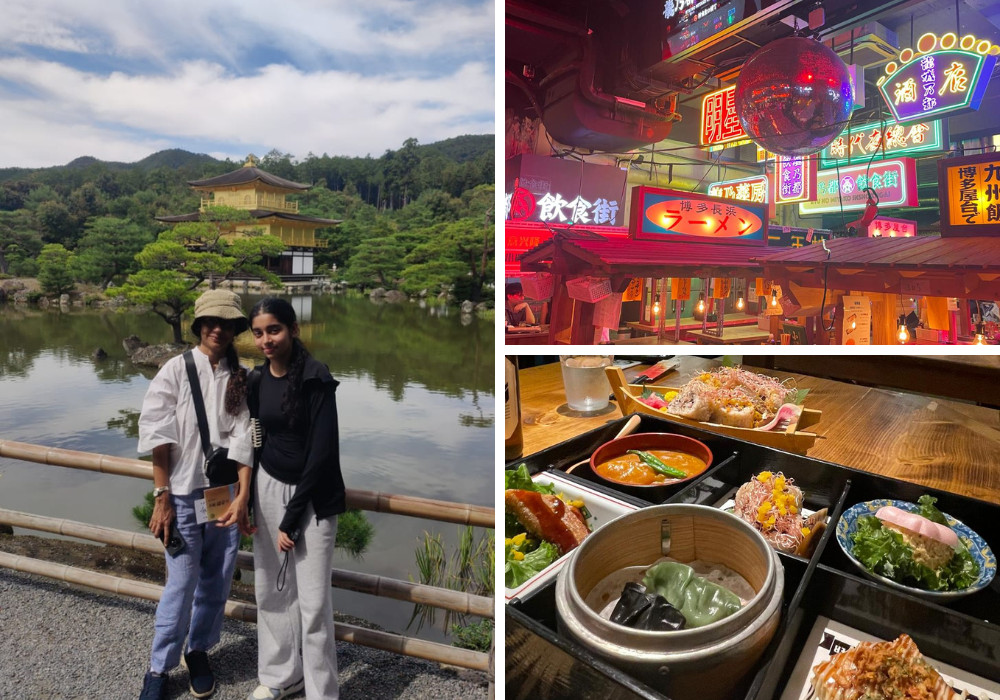Visiting Japan had always been an aspiration, yet synchronising this with the school calendar and the famed cherry blossom season proved elusive. Recently, an unexpected opportunity arose—again missing those iconic blossoms—but it was impossible to pass up a chance to experience the country’s charm. Our visit, in mid-September, greeted us with bright sunshine and temperatures in the low thirties. Hints of autumn appeared at the leaf edges, promising seasonal change. My companion was my fifteen-year-old daughter—we had tagged along with my husband on his work-related visit to Japan. Together, we focused our seven days on Tokyo and Kyoto—five nights in Tokyo and two in Kyoto, though two extra days would have truly done Kyoto justice.
Tokyo: Urban Rhythm and Food Adventures
Tokyo dazzled us with its glassy skyscrapers that meld into a seamless urban tapestry. Despite the multitudes, a sense of order prevails, defined by an unwavering respect for personal space and efficient systems. Queues for trains and escalators exemplify this etiquette—an experience in itself. Eating and loud talking in public are discouraged; the city is a model of cleanliness even though trash bins are scarce (they were removed after the 1995 sarin gas attack)—locals carry their waste and keep the city immaculate.
Given our limited time in the city, we could explore only four of Tokyo's districts. We began with Shibuya, navigating the chaos and spectacle, where thousands cross a five-way intersection in a frenzied scramble when the traffic lights turn red for a mere 30 seconds—a sea of people moving in coordinated bursts.
[The Shibuya Crossing]
The Shibuya Crossing is the “Times Square of Tokyo” with its neon lights and giant video screens. Tourists often stop midway to take photos and make reels, but it’s best viewed from a second-floor Starbucks, like we did. Ramen at an Ichiran—the quick service restaurants you’ll find everywhere—was a culinary highlight. One orders via a machine, and eats solo in cubicles. The cubicles have a small tap for water and instructions on how to order more.
Shinjuku, the next district we explored, is famous for its giant 3D cat billboard. Here we tried the KURA sushi conveyor belt restaurant, which combines fun, technology, and convenience. It was fun dropping the plates in slots on the table—the system counts the plates and bills you based on what you ate.
[The 3D cat billboard at Shinjuku]
The aromas and music wafting from the ubiquitous food alleyways—yokocho—in Asakusa district entice. And Harajuku’s vintage fashion shops and crepe stands add colour and flavour. Ginza sparkles with luxury retailers and quirky concept shops, including the iconic Onitsuka Tiger stores in red and yellow. The Uniqlo store in Ginza is six storeys, the Loft is for quirky gifts, and the coffee shop at the Nissan store asks for your photo to make the froth on your coffee in your image.
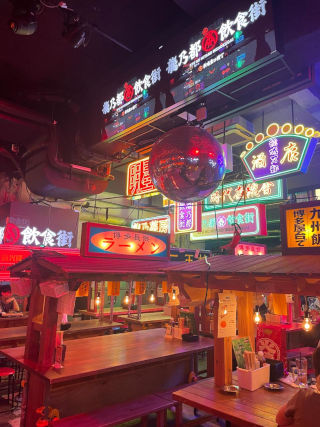
[The entry to a yokocho and the bright interiors]
Tokyo’s parks offer pockets of serenity amid the urban buzz, and an excursion to Tokyo Sky Tree presented city views from above. Team Borderless, a digital art museum, delivered immersive, tech-driven sensory experiences especially loved by my teenager.
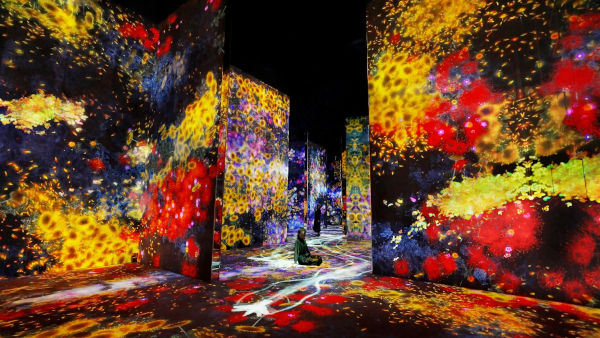
[A still from the digital art museum, Team Borderless. Courtesy TeamLab]
Convenience stores like 7-11 and Lawson became daily staples, offering beautifully packaged quick meals and innovative food options. I wanted to try a fruit smoothie—fruits in a glass sitting on the fridge shelf. I bought it, scanned the barcode at the machine, put in my glass, and the machine blended it. My breakfast was ready.
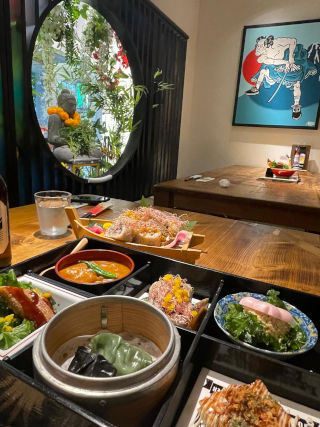
[The attention to detail in every sit-down meal]
For vegetarians, street food can be challenging; convenience stores offer modest assistance, but most meals heavily feature meat.
Journeys by Train and Spiritual Discoveries
Japan’s bullet trains (Shinkansen) are marvels of efficiency, with drivers apologizing for 30-second delays. Most signages are in Japanese but there are enough English signs to get by. Some stations were overwhelming but navigating stations and exits became a fun puzzle, made easier by tech.
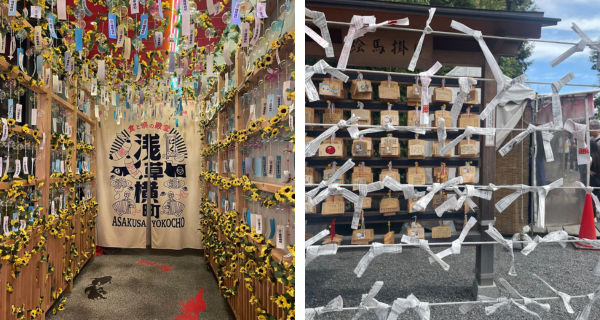
[The gratitude notes hung outside temples]
Cultural encounters included Buddhist temples and Shinto shrines, each epitomising calm and ritual. Visitors wash hands in flowing water, trickling through pipes into huge sinks, before entering. There’s pen and paper to write wishes and gratitude notes. These are hung or deposited in a box; you then bow to the master, clap twice and bow again. The shrines are typically situated in natural settings—near a water body, or with the path through a forest, or on a mountainside. The presence of bonsai gardens, misting stations, and manicured paths once again reveal the Japanese dedication to order and nature.
Kyoto: Zen Gardens, Shrines, and Geisha Stories
A bullet train raced us from Tokyo to Kyoto. A tip: if you sit on the left, on a clear day you can see Mt Fuji.
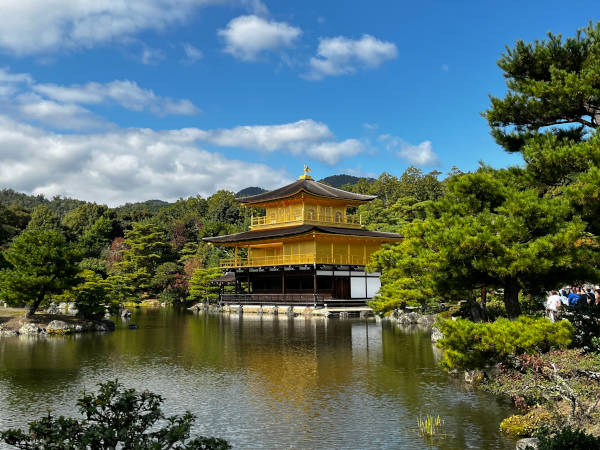
[Kinkakuji, the Golden Pavilion, Kyoto. Photo by 27curlyta - Own work, CC0, via Wikimedia Commons]
Kyoto contrasts Tokyo’s bustle with serenity, best explored by bus. Arashiyama’s bamboo forest walk provided moments of quiet reflection beneath tall stalks. The Fushimi Inari shrine’s 10,000 orange torii gates glow after dusk with light from the lit up paths reflecting off them. The colour orange is sacred in Shintoism. Open 24 hours, the shrine exudes spiritual energy. Kinkakuji (the Golden Pavilion), mirrored in tranquil waters along with the green foliage, was breathtaking.

[L to R: The tall bamboos of Arashiyama forest. The Fushimi Inari shrine]
A meal of tofu hot pot at a small eatery, served in a meditative setting, felt uniquely Japanese—we sat barefoot on mats as the steaming claypot was served. An evening walking tour through Kyoto’s Gion district shed light on the heritage of the Geisha, offering glimpses into tradition and privilege. The modern geishas—some 200 still exist today—are highly-trained in Japanese arts. The Shirakawa river area in Gion district buzzed with nightlife, yet Kyoto’s overall atmosphere remains calm and narrative-rich.
Practical Insights, Missed Sites, and Lasting Memories
Cash payments resulted in a pocketful of coins, promptly fed to coin-hungry convenience store machines. It became a pretext for sampling even more snacks and desserts. Time did not permit visits to Osaka, Nara, or all the day-trip opportunities from Tokyo; next time, a deep exploration of Tokyo station—which is almost like a city in itself, with multiple shopping and eating experiences—and the renowned ramen street in the station’s basement, is on the list. Being tech-savvy is essential here—from navigation to automated adjustments on toilets.
A week in Japan is only a surface skim, as the country offers endless possibilities. Though over 20,000 steps daily exhausted my feet, my spirit felt rejuvenated. The vibrant experiences, the orderly beauty, and the memories created with my daughter will remain cherished for years to come.
Travel Tips
-
Google Maps and Google Translate are essential as signages are mostly in Japanese.
-
Bring sturdy walking shoes—we walked about 20,000 steps daily.
-
For the evening walking tour in Kyoto, I booked through www.kyotolocalized.com. There’s a similar website for Tokyo: www.tokyolocalized.com/. They have free day and night tours covering most of the prominent landmarks.
-
Since this was an unexpected—and therefore unplanned—holiday I followed these Instagram accounts to get quick ideas on what to see and where to go: https://www.instagram.com/japanexperience_en/ ; https://www.instagram.com/japan_tourism.1/ ; https://www.instagram.com/global.and.beyond.travel/ ; https://www.instagram.com/tokyo.explores/
